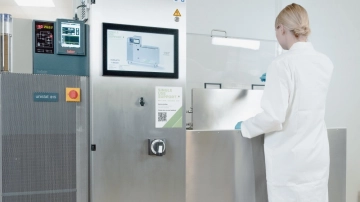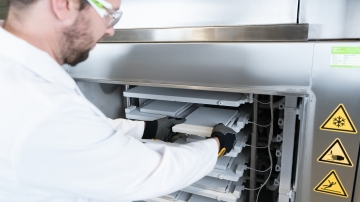The differences between master cell bank (MCB) and working cell bank (WCB)
Table of contents
ShowWhile all working cell banks are derived from a master cell bank, the two different types serve different purposes. A master cell banking system has an overarching function, so to speak, as its main purpose is the production of enough viable cells for WCBs.
Working cell banks, on the other hand, are smaller in quantity, and they are drawn upon for specific projects, providing a renewable and consistent supply of cells used in the manufacturing process.
Master cell bank
Because of its characterization, master cell banks could be described as the mother of all cell banks, providing the raw materials for sub-types such as working cell banks or end-of-production cell banks.
Definition: What is a master cell bank (MCB)?
A master cell bank, MCB in short, serves as the primary source of cells for biologic drugs, cell-based therapies, vaccines and other final products on the biopharmaceutical market. As such, its primary function is to store cells the viability of which has been ascertained by means of various assays.
Any MCB is usually produced from an R&D cell bank (research and development cell bank), which marks the end of cell line development.1
Manufacturing of a master cell bank
MCB manufacturing is a critical process that involves either human, insect or mammalian cell lines. Depending on the intended use, these can include primary cells, stem cells, or cell lines.
Like any cell line development, it requires sterility and is subjected to regulatory and GMP standards. Portions of an MCB are divided into bioprocessing containers like vials or bags for cryogenic freezing – a method used for freezing cells by the means of liquid nitrogen in order to maintain cell viability over extended periods of time.

Working cell bank
Prepared from MCBs under defined cell culture conditions, working cell banks serve as specialized repositories. Following derivation, they can be tapped into for a constant supply of renewable and consistent cells in large-scale biopharmaceutical manufacturing.
Because WCBs also serve as the starting material for biological products (e.g. in monoclonal antibody or recombinant protein production), extensive authentication and quality control testing are necessary prior to expansion.
Master cell bank vs. working cell bank – differences and other types of cell banking
The biggest difference between master cell banks and other types of cell banks, which also include research and development cell banks and end-of-production cell banks, is their intended use. While master cell banks serve as the source for all other types, working cell banks provide an infinite supply of cells for the biopharmaceutical and biotechnological industries.
The main differences between MCBs and WCBs can be summarized as follows:
| Master Cell Bank | Working Cell Bank | |
| Source | Cell lines (established from engineered cells, insect, human or mammalian cells), primary and stem cells, cord blood | Master cell banks |
| Manufacturing | Cell line development from cells isolated from their original tissue source, followed by continuous propagation in stable culture conditions | Amplification of cells derived from MCBs, followed by quality control testing, genetic stability assessment, and cryopreservation for long-term storage |
| Storage Conditions and Duration | Cryopreserved cells are divided in multiple vials or bags that in turn are stored in specialized containers | Cryopreserved cells are divided in multiple vials or bags; usually stored for shorter periods of time than MCBs |
| Purpose | Establishment of a large repository of extensively characterized and validated cells that serve as stable and consistent starting material for other types of cell banks but also for recombinant proteins | Provision of a renewable and consistent source of cells for day-to-day production in biopharmaceutical manufacturing |
| Frequency of Use | Since they serve as a stable reference and starting material, they are used less frequently than those from WCBs | As a renewable and readily available source of cells for day-to-day manufacturing needs, they are used more frequently than MCBs |
MCB and WCB manufacturing
In cell bank manufacturing, any cells prepared for freezing and storage must have undergone extensive sequencing for mycoplasma testing, sterility testing or microbial identification, to name a few.
Cell banks need to be free of any adventitious agents to ensure that only safe raw materials are used for the production of biological products. Professional, FDA- and cGMP-compliant cell banking services can provide either in-vivo or in-vitro testing, and they generally offer a choice of reagents and substrates to assess the cells’ quality, safety and behavior.
Once those characteristics have been ascertained, any cell bank, irrespective of whether it is a master cell bank, a WCB or another type of cell bank, needs to be preserved for storage. This requires both professional fluid management and cryopreservation of cells, all of which can be achieved with comprehensive solutions provided by Single Use Support: The company has developed platform solutions for drug substance manufacturing, including homogenization and aseptic filling platforms or controlled-rate freezers, facilitating cell banking processes and helping to create safe and effective cell banks.
- Mastering Cell Bank Production, https://www.biopharminternational.com/view/mastering-cell-bank-production, Published 2015










